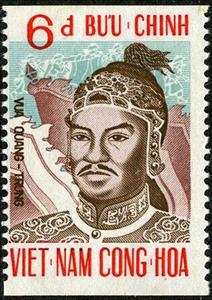Stamp: Emperor Quang Trung (1752-1792) (Vietnam, South 1972)
Emperor Quang Trung (1752-1792) (Vietnam, South 1972)
28 February (Vietnam, South ) within release Emperor Quang Trung goes into circulation Stamp Emperor Quang Trung (1752-1792) face value 6 South Vietnamese đồng
| Stamp Emperor Quang Trung (1752-1792) in catalogues | |
|---|---|
| Michel: | Mi: VN-S 491C |
| Stamp Number: | Sn: VN-S 411a |
Stamp is square format.
Also in the issue Emperor Quang Trung:
- Stamp - Emperor Quang Trung (1752-1792) face value 6;
- Booklet - Emperor Quang Trung (1752-1792) face value 10*6;
Stamp Emperor Quang Trung (1752-1792) it reflects the thematic directions:
The word emperor (from Latin: imperator, via Old French: empereor) can mean the male ruler of an empire. Empress, the female equivalent, may indicate an emperor's wife (empress consort), mother/grandmother (empress dowager/grand empress dowager), or a woman who rules in her own right and name (empress regnant or suo jure). Emperors are generally recognized to be of the highest monarchic honour and rank, surpassing king. In Europe, the title of Emperor has been used since the Middle Ages, considered in those times equal or almost equal in dignity to that of Pope due to the latter's position as visible head of the Church and spiritual leader of the Catholic part of Western Europe. The emperor of Japan is the only currently reigning monarch whose title is translated into English as "Emperor"
Famous People refers to the fame and public attention accorded by the mass media to individuals or groups or, occasionally, animals, but is usually applied to the persons or groups of people (celebrity couples, families, etc.) themselves who receive such a status of fame and attention. Celebrity status is often associated with wealth (commonly referred to as fame and fortune), while fame often provides opportunities to make money.
A flag is a piece of fabric (most often rectangular or quadrilateral) with a distinctive design that is used as a symbol, as a signaling device, or as decoration. The term flag is also used to refer to the graphic design employed, and flags have since evolved into a general tool for rudimentary signalling and identification, especially in environments where communication is similarly challenging (such as the maritime environment where semaphore is used). National flags are patriotic symbols with varied wide-ranging interpretations, often including strong military associations due to their original and ongoing military uses. Flags are also used in messaging, advertising, or for other decorative purposes. The study of flags is known as vexillology, from the Latin word vexillum, meaning flag or banner.



